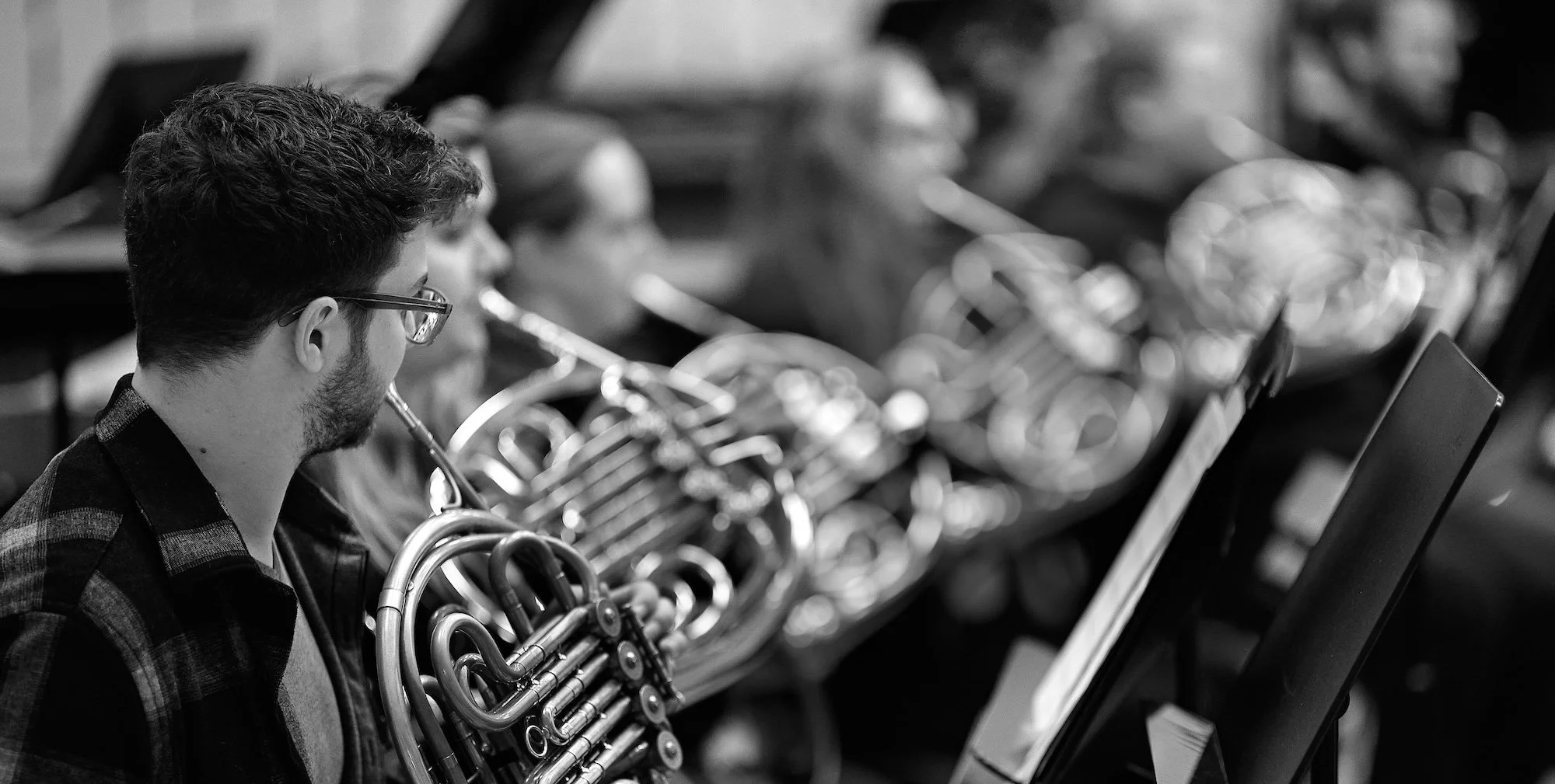Join Encore Wind Ensemble with Jerry Luckhardt
Encore Wind Ensemble
Jerry Luckhardt, Conductor
Sheltering Sky, John Mackey
D'un Matin de Printemps, Lili Boulanger
Symphony No V, Julie Giroux
Concerto for Alto Saxophone, David Maslanka
St. Patrick’s Church, Hudson, WI
Jerry Luckhardt
Jerry Luckhardt, conductor emeritus of Encore Wind Ensemble, is Associate Director of Bands at the University of Minnesota School of Music–Twin Cities, where he conducts the Symphonic Band and teaches conducting.
Luckhardt has appeared as a guest conductor and clinician with ensembles throughout the U.S., Europe, and Asia. He has earned acclaim from composers such as Michael Colgrass, Shelley Hanson, Libby Larsen, Alex Shapiro and Frank Ticheli for performances of their works.
Program Notes
D'un Matin de Printemps (1918) - Lili Boulanger (1893–1918) trans. François Branciard
Lili Boulanger was born into a family of musicians-her Russian-born mother was a singer, and her father, a composer, was awarded the Prix de Rome in 1835. It was at age two that her musical gifts were first noticed. It was also the year that she contracted pneumonia which permanently weekend her immune system. This unfortunate event would affect the rest of her life during which she contracted numerous other infections throughout her childhood and adolescence when finally, tuberculosis would cause her premature death at age 24. Lili Boulanger studied music with her sister Nadia taking private lessons with Georges Caussade, and upon the advice of Gabriel Faure, she then joined the composition class of Paul Vidal at the Paris Conservatory. After several attempts, she was awarded the Prix de Rome in 1913 for her Cantata Faust et Helene. The first woman to have won this prestigious competitive award, many articles were written about her success in the international press, contributing to the emancipation of women.
It was during her final winter days, in 1917-1918, that Lili Boulanger imagined a piece, brimming with life, for violin, cello and piano. This bouncy morning reminder, contemplating soft spring sunshine, was performed for the first time in February 1919 at the Societe Nationale de Musique. This posthumous act was Nadia’s initiative who herself played the piano part. The little sister of the “Boulangerie”- a friendly nickname given to the Parisian household and its three Prix de Rome prize holders.
Sheltering Sky (2012) - John Mackey (b.1973)
The wind band medium has, in the twenty-first century, a host of disparate styles that dominate its texture. At the core of its contemporary development exits a group of composers who dazzle with scintillating virtuosity. As such, one might experience John Mackey’s Sheltering Sky as a striking departure. Its serene and simple presentation is a throwback of sorts- a nostalgic portrait of time suspended.
The work itself has a folksong like quality. Certainly, the repertoire has a long and proud tradition of weaving folk songs into its identity. Whereas composers like Gustav Holst and Ralph Vaughan Williams incorporated existing melodies into their works, Mackey take a play from Percy Grainger and creates a melody entirely original imparting a sense of hazy distance as though they were from a half-remembered dream.
Concerto for Alto Saxophone and Wind Ensemble (1999) - David Maslanka (1943-2017)
The format of Songs and Interludes arises from my other recent works for saxophone “Mountain Roads” and “Song Book” and suggests a music that is more intimate than symphonic.
I. Song: “Fire in the Earth
”Walking through a Montana field on a brilliant late fall day, three images came in rapid succession; a distant tow of red plant stems caught by morning sun, snow on the surrounding high mountains, green grass at my feet. The following poetic image came:
Fire in the earth,
Snow in the heavens
New green grass in the middle of November
This is a quiet, emotional music- sometimes not so quiet- contained by a very simple song form.
Symphony No. 5 “Elements” (2018) - Julie Giroux (b. 1961)
Symphony No. V, “Elements,” is my attempt to describe the three element Sun, Rain and Wind with music. It was my goal to literally submerse the listener in musically graphic situations so much so that, after listening to the respective movements, they would emotionally “feel” like they had been physically touched by each. I wanted to musically present sunrise as well as sunburn the audience with intense heat, then drench and heal them with rain, and finally blow them back against their seats with the power and excitement of wind.
I. Sun in C
Before composing “Sun” I researched all the science I could concerning the sun’s age, projected life span, atomic makeup, flares, and other interesting facts. Formed approximately 4.6 billion years ago and with approximately that many years left, the sun is a radioactive middle-aged ball of hot plasma comprised of 73% hydrogen and 25% helium. Once the sun’s hydrogen fusion core diminishes to a critical level, the sun will go from being classified G-type star referred to as a yellow dwarf to being a Red Giant and will render Earth uninhabitable roughly 5 billion years from now.
The opening of “Sun” actively describes the dynamo process of constant motion in and on the sun. Broken motifs are stated, changed, repeated and grow with strength of numbers and dynamics for 59 quickly paced measures ending in the first sunrise witnessed by earth represented by a huge open fifth C chord which is neither major or minor as there are no thirds. In my mind, I did not see the sun as good or evil-just existing-thus no major or minor overtones. The middle section of “Sun” depicts the sun more as a sentient being with the music showing the loneliness of floating in space for billions of years; the monotony and perhaps the unavoidable onset of insanity and depression such existence would impose on a human as a soulless plant. The sun if then musically devoured by the chemical reactions and builds back up into another huge chord, but this chord is a C Major chord, representing the joy of life that the Earth enjoys, for without the sun, life on earth would not exist. After that chord the music captures the magnificent power of the sun with huge bold chords surrounded by an arsenal of 32nd notes in the woodwinds and keyboards representing the artificial life of the sun and is meant to sound like the artificial synthesized music sounds and textures of the late 1980-1990’s electronic instruments. The miracle of the sun ends the work with another, final massive C Major chord.
II. Rain in Db
The opening of the second movement is my attempt at rain. Literally. The orchestration has the woodwinds and sparse melodic percussion playing notes randomly, both in rhythm and pitch, representing individual rain drops. Solo instruments are added to the random rain, and over the course of 37 measures the entire wind ensemble is added. In measure 38, the raindrops become no longer random, but musically part of each chord in passing. The whole opening section represents a light, random rain.
The middle section of Rain is a representation of the melancholy that comes with rain. The music then builds into a huge downpour, represented by the movement’s main theme. It is big and full, but every once in a while, one measure drops down considerably in both volume and personnel which represents the contrast between looking out at a downpour or staring at individual rain drops on the ground or in your hand.
The middle main theme winds down, dropping down in orchestration to a ‘twinkling’ magical piano and melodic percussion section. This represents the miracle of life water gives to all living things on Earth, without which life would not survive. This section then grows into a recap of the main theme, which gradually reduces to a light, slumber-inviting drizzle ending the movement.
III. Wind in Eb
Starting with a lone Bassoon held note, Mother Nature spins a small breeze with flutes and clarinets. The technical runs which are used throughout the entire movement have built-in motion with up and down movements, many of which happen in each small statement in each instrument. The first wind blows itself out in measure 31-32 with a crescendo and flourish of notes. In measure 33 the wind starts anew with a more devious nature. This wind also winds down, but instead of stopping completely, is lightly formed into a breeze, like that on a beautiful, deserted island or the winds that Peter Pan soars on. Measures 91-125 represent such a wind beginning with, again, the magic “twinkling” of melodic percussion. Jazzy woodwinds are added to the “twinkling” magic with fluid solos in the Alto Saxophone, Clarinet and French Horn representing a perfect breeze playing across bare flesh. This is the first “revisit” of a theme from a previous movement but only in orchestration here, not thematically. Measure 125, sub-headed “Strom Brewing” is exactly that. It starts out small but takes on immense power which abruptly stops and a percussion feature section takes over with driving rhythms and solos. The rest of the wind ensemble is added gradually and quickly grows into a huge tornado which just as quickly disappears. At first it feels like we have escaped the full force of wind but then it hits with hurricane force which drives relentlessly to the end.




